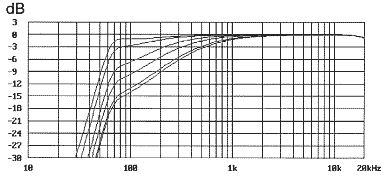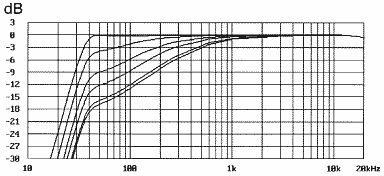The CUT 1 or CUT 2 is inserted between the capsule and the microphone amplifier. The CUT filter performs two tasks:
First, it prevents the effect of infrasonic disturbances from being passed on to any succeeding device.
In particular, pressure-gradient transducers (directional microphones) produce very high infrasonic signal levels when exposed to wind. These can saturate an input transformer or an amplifier stage even before the audible portion of the disturbance becomes noticeable. To avoid this, a very sharp (24 dB/oct) infrasonic filter is...
The CUT 1 or CUT 2 is inserted between the capsule and the microphone amplifier. The CUT filter performs two tasks:
First, it prevents the effect of infrasonic disturbances from being passed on to any succeeding device.
In particular, pressure-gradient transducers (directional microphones) produce very high infrasonic signal levels when exposed to wind. These can saturate an input transformer or an amplifier stage even before the audible portion of the disturbance becomes noticeable. To avoid this, a very sharp (24 dB/oct) infrasonic filter is permanently engaged. It has only a negligible effect on speech, which is the principal field of application for the CUT 1 (cutoff frequency = 60 Hz). The CUT 2's infrasonic filter is an octave lower (i.e. 30 Hz), and has no audible effect on speech pickup whatsoever.
The second task is to offset proximity effect and/or to improve speech intelligibility in reverberant rooms by means of an additional 6 dB/oct rolloff. By turning a recessed thumbwheel the user can vary the frequency at which this begins to have an effect, and thus tailor the low-frequency response as required. Its turnover frequency can be continuously varied between 35 Hz (CUT 2) or 70 Hz (CUT 1) and 600 Hz (see response curveson the Graphics page).


